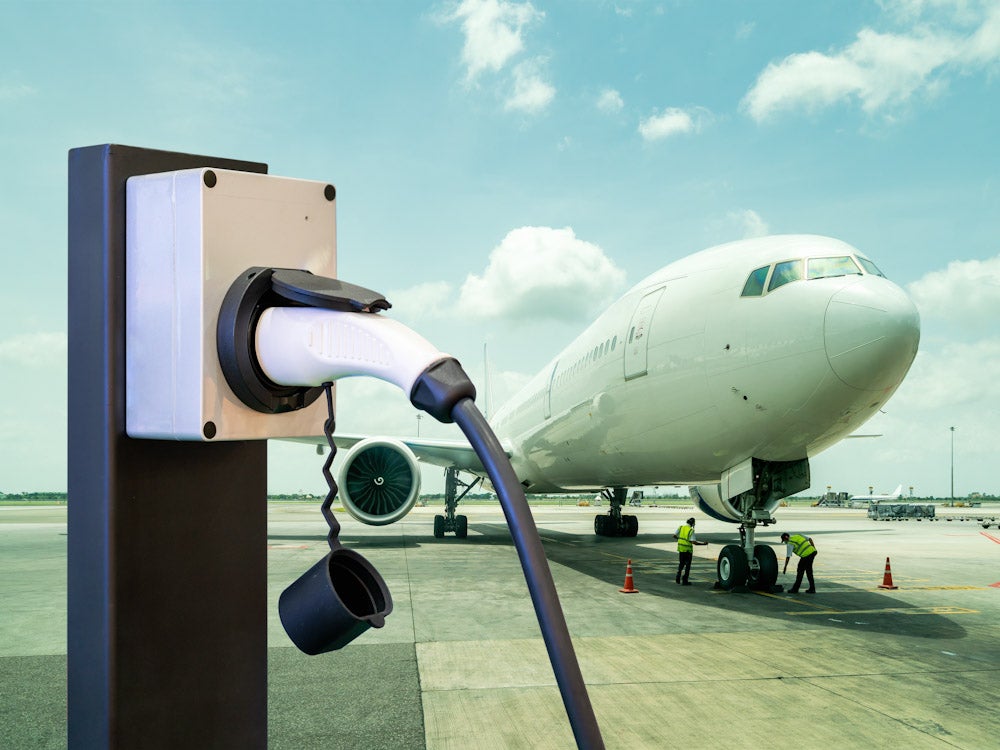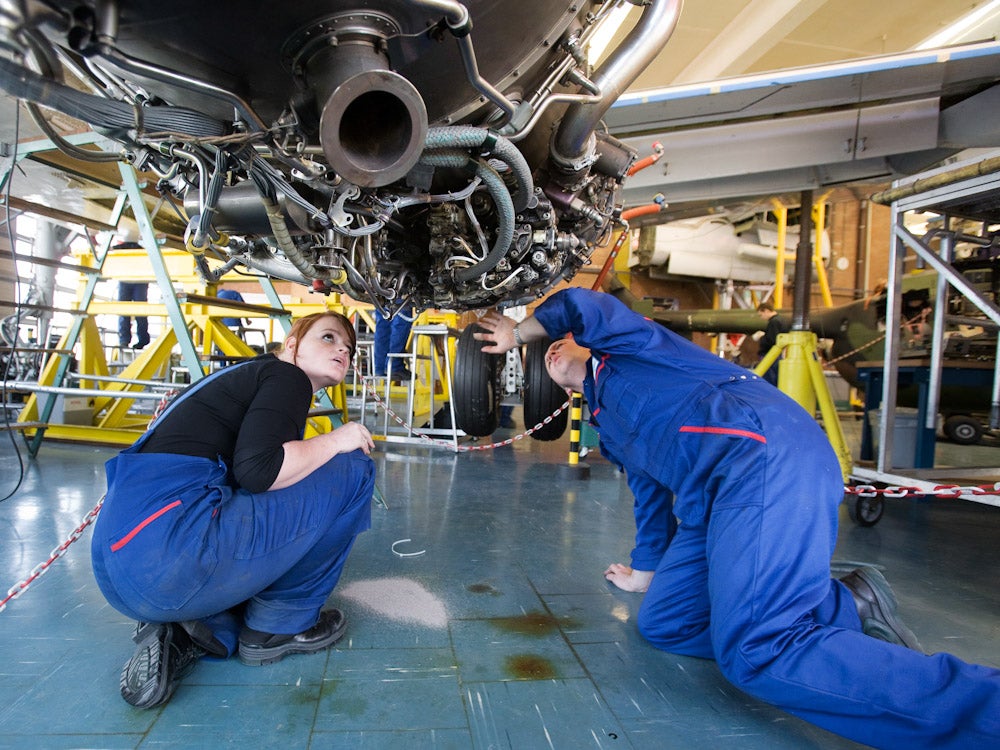
The rapid development of rechargeable batteries in the automotive industry is now providing an opportunity for electric planes to slash the carbon footprint of the aviation sector. Before the end of this decade, it will be possible to fly up to 500km on one electric flight in a plane carrying several dozen passengers. Travel will be quieter, without condensation trails and carbon-free.
While electric long-haul flights are not expected to be possible within the next couple of decades, short domestic flights and flight-training aircraft are proving the technology. There are several electric planes already in commercial use, such as the two-seater Velis Electro used for pilot training. And the range of e-planes available is expected to grow, just as electric cars have evolved over the last few years.
Power Up is a Netherlands-based innovation project between Eindhoven Airport, Rotterdam The Hague Airport, Groningen Airport, and Maastricht Aachen Airport. Supported by Royal Schiphol Group and the Netherlands Aerospace Centre, Power Up is involved in researching the possibilities of sustainable electric flight.
Before any commercial flight can take place, a robust, easy-to-use, charging system must be available. Unlike creating an electric train network, the advantage here is that major infrastructure such as airport buildings and runways already exist. What’s more, the roofs of these buildings can be fitted with solar panels to harvest green energy.
Transitioning to electric planes
Working with first mover airports and electric aircraft manufacturers is electric charging system pioneer NRG2fly, a start-up that features some serious engineering credentials. Maarten Steinbuch, scientific director at Eindhoven Engine, and Distinguished Professor at Eindhoven University of Technology, recently formed the company along with Jeroen Kroonen, a pioneer in sustainable mobility; along with Jurjen de Jong, founder of ‘green tech’ companies Green Future Management and GreenFlux, with huge experience in eMobility and renewable energy.
Transitioning to e-planes has been made possible by the electric automotive industry, and notable advances are taking place within the Netherlands, says Professor Steinbuch. “In our region, we have a lot of activities regarding batteries, battery management, and new battery types,” he says. “We have an automotive campus in Helmond, part of the Brainport region, featuring a Battery Competence Centre. We are very active in the electrification of mobility, and electric flying is just a new branch on the tree.”
Solutions to problems such as heat propagation, optimisation of battery capacity, and lifecycle analysis, have already been addressed, Steinbuch explains. “Also, think about the education of people. Converting a fleet of aircraft to electric means that you don’t just need mechanics, but also electro-technical people and ICT skills.”
The Netherlands province of Brabant is a well-known hive of activity when it comes to high-tech technological innovations. Developments are also taking place for the electric transition, with collaborations between industry, education institutes and government, known as the Triple Helix, working together to create opportunities and drive economic success in the region. With a locally educated workforce, the right experience and skills to enable advances are already within the area.
Brabant has also proven that its high-tech ecosystem is a highly effective incubator for new mobility businesses, producing internationally successful companies such as Lightyear and PAL-V.
Technical talent and companies are developing new e-mobility solutions together, with a shared vision to build a future-proof industry.
Moreover, a number of internationally renowned aerospace companies have established a presence in Brabant to provide services for the Royal Netherlands Air Force (NLAF) and the MRO activities for the European F-35 program. However, these companies are also involved in various non-military innovation projects that are related to the electrification of aircraft.
The combination of a strong high-tech cross-sectoral ecosystem, cooperation with various global aerospace partners and the presence of a dynamic start-up environment, all help make Brabant an optimum location to facilitate the value chain for electric aviation.

Low-cost sustainable charging for carbon-free aviation
E-planes can help to reach ‘green goals’ and reduce costs for aviation at the same time, says Steinbuch. “If the sustainable system is the best system you can buy, then more people will buy it,” he adds. “If the price per kilometre is right, it will sell itself.”
Jeroen Kroonen explains how the system works: “The energy infrastructure includes the grid connection, energy storage and solar energy for the operations of electric flying from that airfield.
International Airport Teuge, located in the east of the Netherlands, is the airport with the most electric flights in Europe at the moment. E-Flight is a fully electric aviation training school. They make a lot of flights, and NRG2fly provides them with knowledge and engineering for setting up the charging and energy infrastructure.
“If somebody comes over from another airfield, with a different plane, they should also be able to charge it using our future system. The airport authority and operator can do the payments and allow for guest charging.”
This integrated approach is key, with the system designed for easy charging and payments, explains Kroonen.
The plan is to expand the availability of charging as electric planes evolve. E-planes are currently small, propellor-driven, short-haul flyers or used for training. “If you have 3,000 airports in greater Europe, you can in due time electrify many of the short-haul flights. About 80% of all the flights are less than 1,000km,” says Jurjen de Jong. And a bonus is the much lower sound levels from aircraft. “The noise pollution is significantly less,” says de Jong, “I take electric flying lessons myself at the flying school and it’s incredibly quiet.”
Advances in battery technologies
The efficiency of the electric system is about four times that of a petrol-driven engine, explains de Jong. “The bottleneck for aerospace applications is batteries. You need a lot of batteries in the air, and although it’s more efficient, jet fuel contains much more energy per kilogramme. Currently, you can e-fly 200km. But in five to ten years, as batteries improve, it’ll be 500 km. Now you have two-person planes, but it will go to ten, to 20 or even 40 people.”
Lithium-ion batteries are used in e-planes, but future technologies are expected to develop to further efficiencies. “Energy density will increase in the near future,” explains Kroonen. “Of course, there are also other battery chemistries out there coming along, but we don’t need that for our business case for the next ten years. In the meantime, we can trust the development curves of the lithium-ion family of battery development.”
This is also one of the reasons that the value chain for electric flying – represented by EVC, a Dutch collective for electric flying – works closely with the Battery Competence Centre in Helmond.
Battery charging facilities at airports
Static storage is also something the team is looking into, which could be enterprising for the airports. “We want to have solar panels at every airport, so the airfields can generate their own energy,” says Kroonen. “Energy comes in slowly to the battery from the solar panels and grid, but you can charge very fast from the battery, charging the plane within half an hour.”
De Jong suggests that energy hubs at every airport could have other benefits. “You’re making, fast, sustainable energy, even at airfields which are in the middle of nowhere,” he says. “If you put charging infrastructure and solar storage in that airfield, it’s an energy hub for that environment, in addition to its own electrification transition of ground operations.”
Kroonen adds that close cooperation in Brabant has been key to their work. “Together with our partners we are setting up a whole new mobility sector,” he says. “Aviation has always been at the forefront of mobility innovation, especially when it comes to being lightweight, reliable, and safe.”
To learn how Brabant’s history of innovation is attracting investment to fund the technologies of the future such as electric planes and solar-powered cars, download this white paper.


